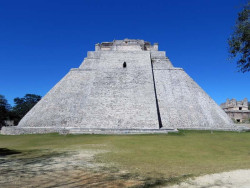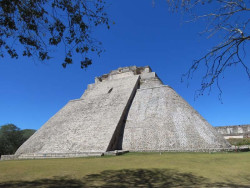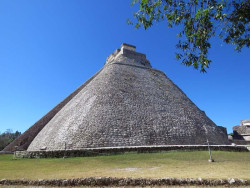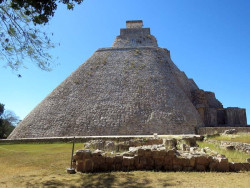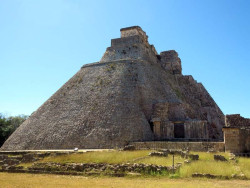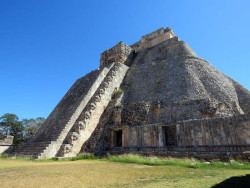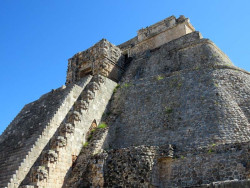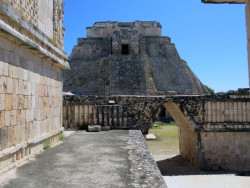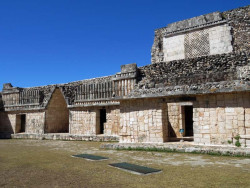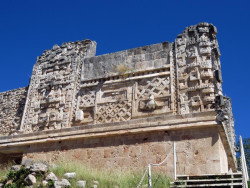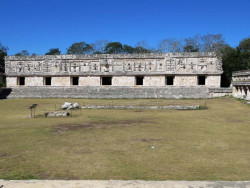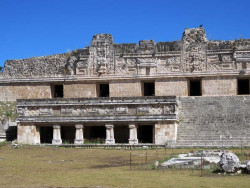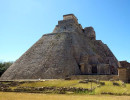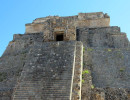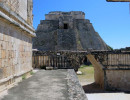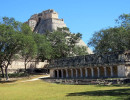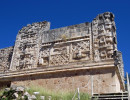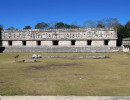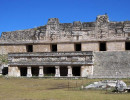- You are here:
- Home
- Man-made
- Archeological Sites
- Uxmal in Mexico
Uxmal in Mexico
The Mayan Archeological Site of Uxmal in Mexico
Uxmal is an ancient Maya city of the classical period located in present-day Mexico. Uxmal is considered one of the most important archaeological sites of Maya culture, along with Palenque, Chichen Itza and Calakmul in Mexico, Caracol and Xunantunich in Belize, and Tikal in Guatemala. Located in the Puuc region of the western Yucatán Peninsula, Uxmal is considered one of the Maya cities most representative of the region's dominant architectural style. It has been designated a UNESCO World Heritage Site in recognition of its significance.
The present name seems to derive from Oxmal, meaning "three times built." This seems to refer to the site's antiquity and the times it had to rebuild. The etymology is disputed; another possibility is Uchmal which means "what is to come, the future." By tradition, this was supposed to be an "invisible city," built in one night by the magic of the dwarf king. The Maya legend "The Dwarf-Wizard of Uxmal" is set in Uxmal.
Uxmal's buildings are noted for their size and decoration. Ancient roads called "sacbes" connect the buildings, as well as to other cities in the area such as Chichén Itzá, Caracol, Xunantunich, and Tikal.
Its buildings are typical of the Puuc style, represented by columns and trapezoidal shapes. Entwined snakes and, in many cases two-headed snakes are used for masks of the rain god, Chaac; its big noses represent the rays of the storms. Feathered serpents with open fangs are shown leaving from the same human beings. Also seen in some cities are the influences of the Nahua peoples, who followed the cult of Quetzalcoatl and Tlaloc. These were integrated with the original elements of the Puuc tradition and take advantage of the terrain to gain height, including the Pyramid of the Magician, with five levels, and the Governor's Palace, which covers an area of more than 12,917 sq ft.
A large Ballcourt for playing the Mesoamerican ballgame. Its inscription says that it was dedicated in 901 by the ruler Chan Chak K'ak'nal Ajaw, also known as Lord Chac. The ball court's condition is very deteriorated, and it’s made of two constructions of medium dimensions that make up the sides of the court with the rings by which the ball was to be introduced. The originally carved stone rings were removed to protect them from the elements and were replaced by reproductions. This game has always been related to mythical and cosmic aspects. The ball symbolized the movements of the stars in the sky and the players, in repeated occasions, symbolically staged the fight of the day against the night or the struggle of the deities of the underworld against the gods of heaven.
Sylvanus G. Morley made a map of the site in 1909 which included some previously overlooked buildings. The Mexican government's first project to protect some of the structures from risk of collapse or further decay came in 1927. In 1930 Frans Blom led a Tulane University expedition to the site. They made plaster casts of the façades of the "Nunnery Quadrangle"; using these casts, a replica of the Quadrangle was constructed and displayed at the 1933 World's Fair in Chicago, Illinois. The plaster replicas of the architecture were destroyed following the fair, but some of the plaster casts of Uxmal's monuments are still kept at Tulane's Middle American Research Institute. In 1936 a Mexican government repair and consolidation program was begun.
Queen Elizabeth II of the United Kingdom visited on 27 February 1975 for the inauguration of the site's sound & light show. When the presentation reached the point where the sound system played the Maya prayer to Chaac (the Maya rain deity), a sudden torrential downpour occurred.
Photographed in 2024.














































